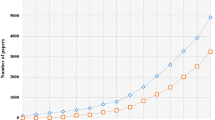Abstract
In this work, we compare the difference in the number of citations compiled with Scopus as opposed to the Web of Science (WoS) with the aim of analysing the agreement among the citation rankings generated by these databases. For this, we analysed the area of Health Sciences of the University of Navarra (Spain), composed of a total of 50 departments and 864 researchers. The total number of published works reflected in the WoS during the period 1999–2005 was 2299. For each work, the number of citations in both databases was recorded. The results indicate that the works received 14.7% more citations in Scopus than in WoS. In the departments, the difference was greater in the clinical ones than in the basic ones. In the case of the rankings of citations, it was found that both databases generate similar results. The Spearman and Kendall-Tau coefficients were higher than 0.9. It was concluded that the difference in the number of citations found did not correspond to the difference of coverage of WoS and Scopus.
Similar content being viewed by others
References
Aguillo, I., Granadino, B., Ortega, J. L., Prieto, J. A. (2006), Scientific research activity and communication measured with cybermetrics indicators, Journal of the American Society for Information Science and Technology, 57(10): 1296–1302.
Bakkalbasi, N., Bauer, K., Glover, J., Wang, L (2006), Three options for citation tracking: Google scholar, scopus and web of science, Biomedical Digital Library, 3(7). http://www.bio-diglib.com/content/3/1/7
Ball, R., Dirk, T. (2006), Science indicators revisited — Science Citation Index versus SCOPUS. A citation comparison of both citation dababases, Information Services & Use, 26: 293–301.
Bar-Ilan, J., Levene, M., Lin, A. (2007), Some measures for comparing citation databases, Journal of Informetrics, 1(1): 26–34.
Braun, T., Glänzel, W., Shubert, A., How balanced is the Science Citation Index’s Journal Coverage? A preliminary overview of macrolevel statistical data. In: Cronin, B., Atkins, B. (Eds), The Web of Knowledge: A Festschirft in Honor of Eugene Garfield. Information Today, 2000, pp. 251–277.
Buela-Casal, G., Gutierrez-Martinez, O., Bermudez-Sanchez, M., Vadillo Muñoz, O., (2007), Comparative study of international academic rankings of universities, Scientometrics, 71(3): 349–365.
Codina, L. (2005), Scopus: el mayor navegador científico de la web, El Profesional De La Información, 14(1): 44–49.
CWTS. The changelles of University Rankings. http://www.cwts.nl/cwts/LeidenRankingWebSite.html
Este Pipp, E. (2006), Web of Sciences erfassten Zeitschriften, Online Mitteilungen, 85: 3–17.
Garfield, E. (1990), How ISI selects journals for coverage: quantitative and qualitative considerations, Current Contents, 28(22): 5–13
Gorraiz, J., Schloegl, C. (2007), A bibliometrics analysis of pharmacology and pharmacy journals: Scopus Versus Web of Science, Journal of Information Science [In press]
Gorraiz, J., Schloegl, C. (2007), Comparison of two counting houses in the field of pharmacology and pharmacy. In: Torres-Salinas, D., Moed, HF. (Eds), Proceedings of ISSI 2007. 11th International Conference of the International Society for Scientometrics and Informetrics. CINDOC, 2007, pp. 854–855.
Jacso, P. (2005), As we may search — Comparison of major features of the Web of Science, Scopus and Google Scholar citation-based and citation-enhanced databases, Current Science, 89(9). http://www.ias.ac.in/currsci/nov102005/1537.pdf
Klavans, R., Boyack, K.W. (2007), Is there a Convergent Structure of Science? A Comparison of Maps using the ISI and Scopus Databases1. In: Torres-Salinas, D., Moed, HF. (Eds), Proceedings of ISSI 2007. 11th International Conference of the International Society for Scientometrics and Informetrics. CINDOC, 2007, pp. 437–448.
Laguardia, C. (2005), E-views and reviews: Scopus Vs Web of Science, Library Journal, 15. http://www.libraryjournal.com/article/CA491154.html
Moya-Anegón, F., Chinchilla-Rodríguez, Z., Vargas-Quesada, B., Corera-Álvarez, E., Muñozfernández, F., Gónzalez-Molina, A. (2007), Coverage analysis of Scopus: A journal metric approach, Scientometrics, 73(1): 53–78.
Norris, M., Oppenheim, C. (2007), Comparing alternatives to the Web of Science for coverage of social science’s literature, Journal of Informetrics, 1: 161–169.
Van Raan, A. F. J., (2005), Fatal attraction: Conceptual and methodological problems in the ranking of universities by bibliometrics methods, Scientometrics, 62(1): 133–143.
Wessa, P. (2007), Free statistics software, office for research development and education. http://www.wessa.net
Author information
Authors and Affiliations
Corresponding author
Rights and permissions
About this article
Cite this article
Torres-Salinas, D., Lopez-Cózar, E.D. & Jiménez-Contreras, E. Ranking of departments and researchers within a university using two different databases: Web of Science versus Scopus. Scientometrics 80, 761–774 (2009). https://doi.org/10.1007/s11192-008-2113-9
Received:
Published:
Issue Date:
DOI: https://doi.org/10.1007/s11192-008-2113-9




